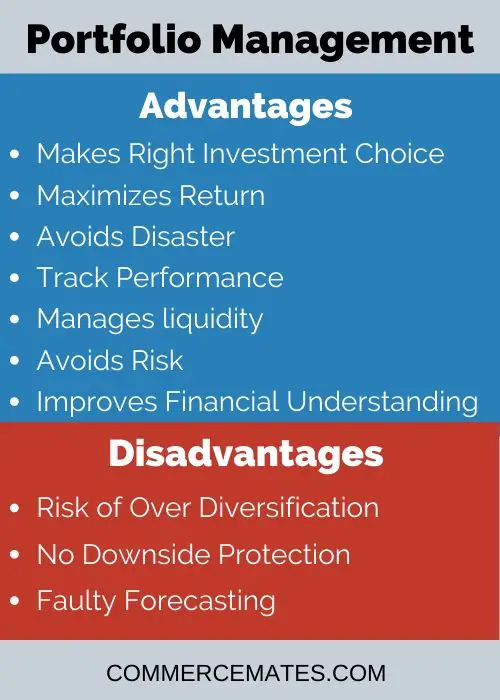Contents
Meaning of Portfolio Management
Portfolio Management is the process of creating and managing an appropriate portfolio of investments. It is an art and science of choosing a suitable mix of investments in accordance with financial goals and risk tolerance of the investor. The term portfolio management is also known as “Asset management’’ or “Wealth management’’.
Portfolio management aims at increasing return on investment and maximizing the wealth of investors through deciding an optimal portfolio. Portfolio simply refers to various investment tools like shares, bonds, mutual funds, stock, FDs, and cash equivalents in which people invest their money to generate income.
Portfolio management serves the purpose of maximum returns at minimum risk within the given time frame. It performs the SWOT analysis of an investment avenue before including it in the portfolio. There are different types of portfolio management like active, passive, discretionary, and non-discretionary portfolio management.

Advantages of Portfolio Management
Makes Right Investment Choice
Portfolio management is a tool that helps the investor in choosing the right portfolio of assets. It enables in making more informed decisions regarding investment plans in accordance with the goals and objectives.
Maximizes Return
Maximizing the return is one of the important roles played by portfolio investment. It provides a structured framework for analyses and selecting the best class of assets. Investors are able to earn high returns with limited funds.
Avoids Disaster
Portfolio management avoids the disaster of facing huge risks by investors. It guides in investing among different classes of assets instead of investing only in one type of asset. If an investor invests in only one type of security and supposes it fails, then the investor will suffer huge losses which could be avoided if he might have invested among different assets.
Track Performance
Portfolio management helps management in tracking the performance of their portfolio of investments. A consolidated investment held within the portfolio can be evaluated in a better way and any of its failures can be easily detected.
Manages liquidity
Portfolio management enables investors in arranging their investment in a systematic manner. Investors can choose assets in such a pattern where they can sell some of them easily whenever they need funds.
Avoids Risk
Investment in securities is quite risky due to the volatility of the security market which increases the chance of losses. Portfolio management helps in reducing the risk through diversification of risk among large peoples.
Improves Financial Understanding
It helps in improving the financial knowledge of investors. While managing their portfolio they came across numerous financial concepts and learn how a financial market works which will enhance the overall financial understanding.
Disadvantages of Portfolio Management
Risk of Over Diversification
Sometimes portfolio managers invest funds among large categories of assets whose control becomes impossible. In his efforts to diversify the risk it goes beyond the limit to manage efficiently. Loss arising in such situations is quite high and can bring serious repercussions.
No Downside Protection
Portfolio management only reduces the risk through diversification but does not provide full protection. At times of market crash, the concept of portfolio management becomes obsolete.
Faulty Forecasting
Portfolio management uses historical data for evaluating the returns of securities for investment purposes. Sometimes the historical data collected is incorrect or unreliable which leads to wrong forecasts.